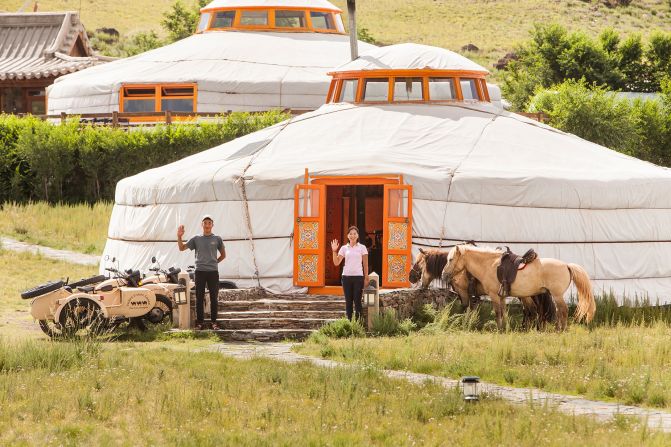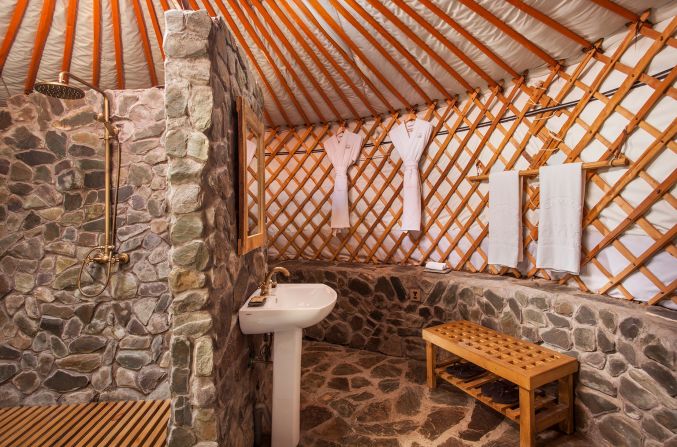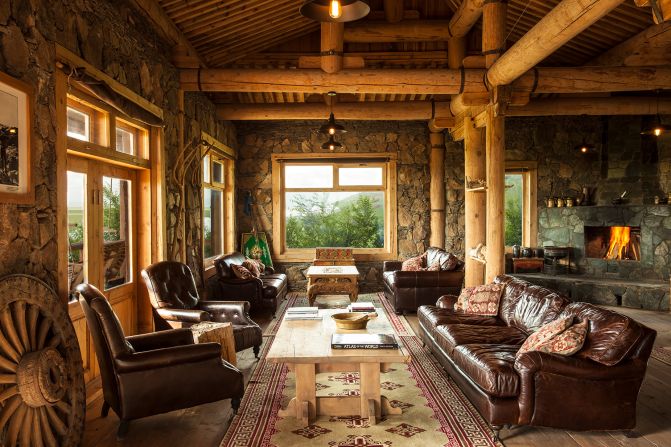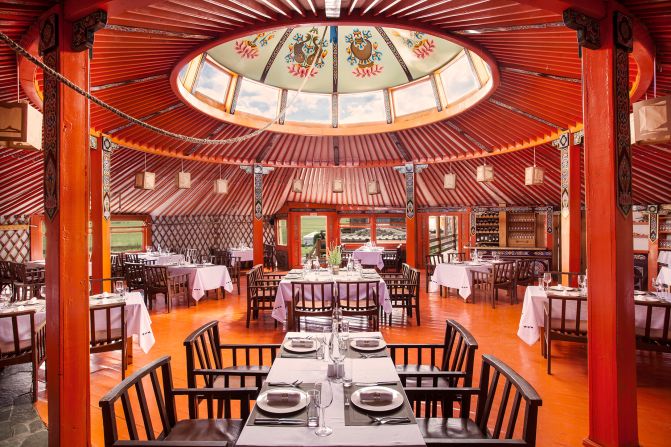Editor’s Note: This CNN Travel series is, or was, sponsored by the country it highlights. CNN retains full editorial control over subject matter, reporting and frequency of the articles and videos within the sponsorship, in compliance with our policy.
It’s early morning and an orange glow has filled the sky as the sun slowly rises over a seemingly endless desert landscape.
Every few hours, herders walk into view, hundreds of sheep and goats in tow as they make their way to the nearby water well.
The only sounds to be heard are the wind, the brays and barks of native animals and the occasional rumbles of 4x4 vehicles bringing new arrivals.
It’s all part of the isolated wilderness experience on offer at the Three Camel Lodge, an eco-resort in Bulgan in Mongolia’s Gobi (which means desert), one of the most remote places on Earth.
Far from civilization, the lodge aims to give visitors an up-close look at Mongolia’s traditional nomadic lifestyle – a community of people who survive on the Central Asia plateau by relying on domesticated livestock.
While there aren’t many nomadic cultures left in the world, it’s still very much an integral part of Mongolian life. Today, nomads make up around a quarter of the country’s population of more than 3 million people.
The lodge has 40 gers. These round, tent-like dwellings are made of wood, felt and rope – materials flexible enough to be carried around, easily assembled and strong enough to withstand the desert’s strong winds.
Inside, the set-up is simple – there are wooden pieces of furniture and other bits of decor. But each one features luxuries not usually found in a nomad’s home – like a private bathroom with running water and electricity powered by solar energy.
The Three Camel Lodge also has an on-site restaurant, a bar (with a very extensive whiskey selection) and even a spa – surprisingly extravagant, especially in this part of the world.
How the Three Camel Lodge was born
The Three Camel Lodge was the brainchild of 68-year-old Mongolian-American businessman Jalsa Urubshurow.
As a child growing up in the US in the 1960s, he could only dream of the dramatic landscapes of Mongolia. But the country’s culture was always in his heart, thanks to his father’s colorful stories.
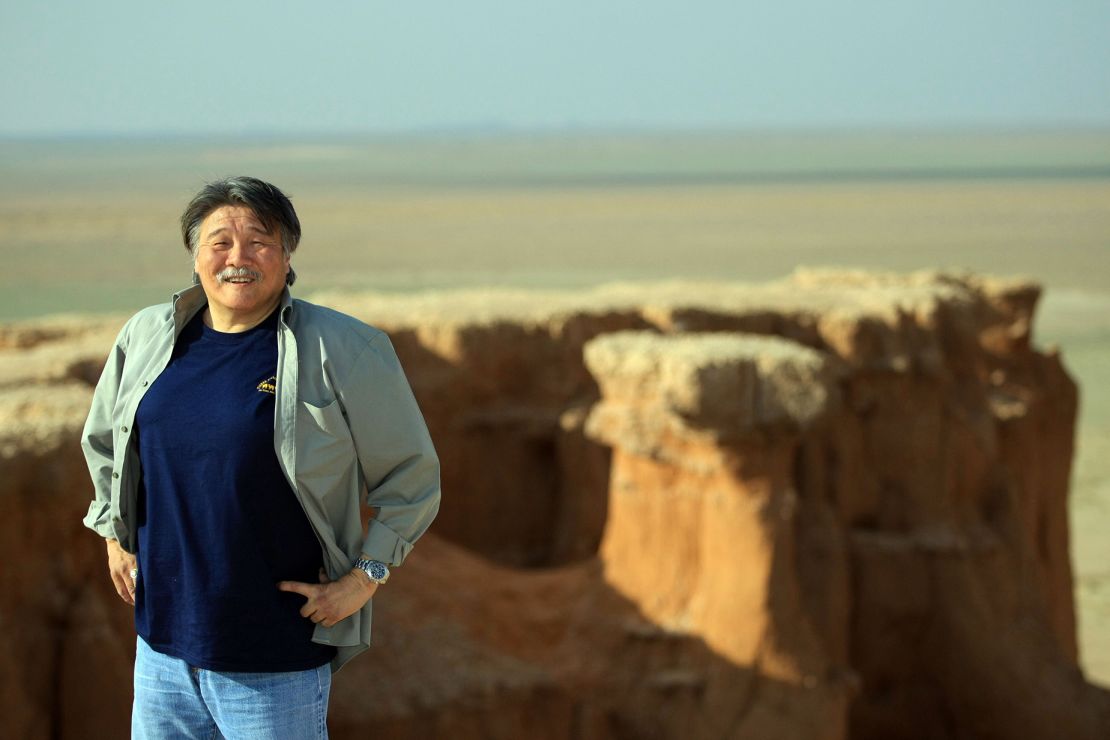
“Mongolians have a pretty accurate genetic tracing system … you can pretty much determine what geographical region within several 100-mile radiuses where your tribe, your ancestors originated,” says Jalsa, whose father was born in Kalmykia, now a southern region of Russia.
“(My father) reminded me of this in the middle of New Jersey while I was growing up.”
In the early 1990s, when Mongolia opened its borders to international tourists, Jalsa was able to visit for the first time.
“I’ve been to many Mongolian weddings in New Jersey, you know, but that was the extent of it. (The visit) invoked so many different images,” he says.
“I got to go out to the countryside and meet a herder and stay in some ger camps … it was an amazing experience.”
Soon after, Jalsa was tasked by the prime minister of Mongolia to bring in more travelers from the West. In 1992 he started a travel services company, Nomadic Expeditions, providing tours in Mongolia and other countries.
“It took me two years to get anyone to come,” he recalls.
In 2002, Jalsa decided to build something more permanent in the Gobi, and the Three Camel Lodge was born.
A land of dinosaurs and flaming cliffs
The Gobi is known as the land of the dinosaurs – and it’s an intrinsic part of Mongolian culture.
Just a half-hour drive away from the Three Camel Lodge is one of the most important dinosaur fossil sites in the world.
At Bayanzag, explorers made the first scientifically-recognized discovery of dinosaur eggs a century ago. While finding the nests with his team from the American Museum of Natural History in the 1920s, paleontologist Roy Andrews aptly named the site “The Flaming Cliffs” after the red sandstones that seem to come to life at sunset, turning the entire area into a fiery red color.
Here, dinosaur fossils are still being found today.
“This place is really mysterious … it’s kind of secretive and secluded. It’s really a special place for me,” Buyandelger Ganbaatar, Nomadic Expeditions’ in-country director and lead tour guide, tells CNN Travel.
“It used to be sand dunes about 70 million years ago. The Flaming Cliffs was known as an ancient settlement. One of the reasons for Andrews’ expedition was to prove that humankind originated in Central Asia and he was looking for the evidence.”
Speaking of dunes, another popular area attraction within reach of the lodge is Moltsog Els – a mere 15-minute drive. Despite being in the desert, it’s one of just a few regions in the Mongolian Gobi that’s covered in mounds of sand.
Here, guests can explore the dunes on foot or hire a camel from one of the local herding families around the area.
Beyond dunes and red stone cliffs, the Gobi is also famous for its greenery. An hour’s drive from the lodge, Yol Valley was originally established to conserve birdlife, including the Yol, or bearded vulture.
Guests can also journey to the protected Gobi Gurvan Sakihan National Park, which is rich with biodiversity – from white gazelles to leopards and golden eagles. The valley can be explored on foot or horseback – in the summer, a brook runs through the deep and narrow gorge.
Other experiences on offer at the lodge include nomadic archery sessions, stargazing, cycling and cooking classes.
Sustainability pioneer
With such pristine nature all around, preservation has been critical from the get-go. Being in an area so remote, it was important for Jalsa and his team to put the right infrastructure in place.
Considered a pioneer in sustainable tourism, the Three Camel Lodge today follows three main pillars: sustainable stewardship, preservation and community empowerment.
The lodge started by eliminating single plastic bottles, instead handing out metal reusable tumblers to its guests. They also built a waste management system from scratch, diverting garbage from landfills by creating a greenhouse for composting. Solar panels power nearly all of the lodge’s lighting. Materials for construction, furniture and décor are sourced as locally as possible – within 50 miles of the lodge.
“I think you have to have a commitment through architecture, your surroundings and design and operations to the culture that you’re trying to promote,” says Jalsa. “Finding some level of authenticity that is constant, that’s the underlying spirit. Ongoing sustainable tourism is based on hiring locally.”
For Jalsa, that means investing in local people. There are nearly 30 full-time Mongolian staff at the Three Camel Lodge – and it was important that they share the same sentiment.
“It’s a wonderful thing if you can be protecting our planet, and sharing your culture with people,” he says.
Investment in the wider Gobi community is also an important part of the lodge’s sustainability goals, whether that is supporting educational programs or working with international paleontological organizations to help protect dinosaur fossils.
“Mongolia is one of the last places you can get away and see pristine wilderness and wonderful landscapes,” says Jalsa.
Getting there
Getting to and from the Three Camel Lodge isn’t for the travel-weary – did we mention it’s remote?
“It’s a seven, eight-hour drive (to the Gobi), and your average tourist doesn’t want that,” Jalsa tells CNN of the journey from Mongolia’s capital, Ulaanbaatar.
There are flights to the Gobi but they tend to depart in the middle of the night and arrive at Dalanzadgad Airport just as the sun starts to rise. After that, it’s another hour-long car ride across the roadless desert before the lodge emerges in the distance, almost like an oasis.
Getting out of the Gobi can be even more complicated – flights back to the capital are often canceled (ours were axed, twice) with short notice. In the winter, some flights don’t operate at all.
Currently, Jalsa says the lodge is open for business from the beginning of May until November. He hopes there can be more support from the government to improve logistics and also expand the annual tourism season, at least “just a little longer.“
“I think the government, for them to embrace tourism, they (should) subsidize air travel domestically, especially if it’s for tourism,” Jalsa says.
“Essentially, you’re bringing clients to the country, and you make places within the country accessible for them. I think it’s a wonderful opportunity, and we’ve been working for 30-plus years to put it on the map.”


